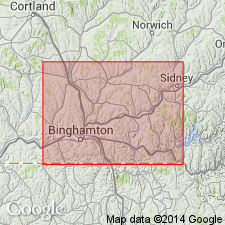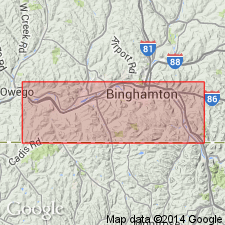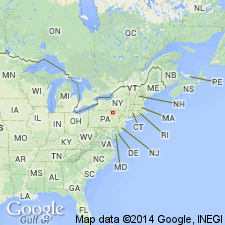
- Usage in publication:
-
- Corning Member
- Modifications:
-
- Overview
- Dominant lithology:
-
- Shale
- AAPG geologic province:
-
- Appalachian basin
Summary:
Pg. 90, 95 (fig. 4). About 5 feet of Corning Member exposed in Corbisello quarry at Binghamton. Consists of gray fissile shale. Underlies New Milford Formation.
Source: US geologic names lexicon (USGS Bull. 1350, p. 175).

- Usage in publication:
-
- Corning Member
- Modifications:
-
- Named
- Dominant lithology:
-
- Shale
- Siltstone
- AAPG geologic province:
-
- Appalachian basin
Summary:
Pg. 77. Corning Member of Gardeau Formation. A sequence of very dark gray shales and thin-bedded gray siltstones about 40 feet thick. Present at top of formation. Underlies New Milford Formation. Type section stated. Name credited to Twigg (unpub. thesis 1961). Recognized in south-central New York. Age is Late Devonian.
Type section: cliff exposure south of New York Highway 17 at west edge of Corning (975 ft elevation) where Highway 17 bridges the railroad, central NY.
Source: US geologic names lexicon (USGS Bull. 1350, p. 174-175).

- Usage in publication:
-
- Corning Member
- Modifications:
-
- Areal extent
- AAPG geologic province:
-
- Appalachian basin
Summary:
Pg. 85. Geographically extended into northern Pennsylvania.
Source: US geologic names lexicon (USGS Bull. 1350, p. 175).
For more information, please contact Nancy Stamm, Geologic Names Committee Secretary.
Asterisk (*) indicates published by U.S. Geological Survey authors.
"No current usage" (†) implies that a name has been abandoned or has fallen into disuse. Former usage and, if known, replacement name given in parentheses ( ).
Slash (/) indicates name conflicts with nomenclatural guidelines (CSN, 1933; ACSN, 1961, 1970; NACSN, 1983, 2005, 2021). May be explained within brackets ([ ]).

